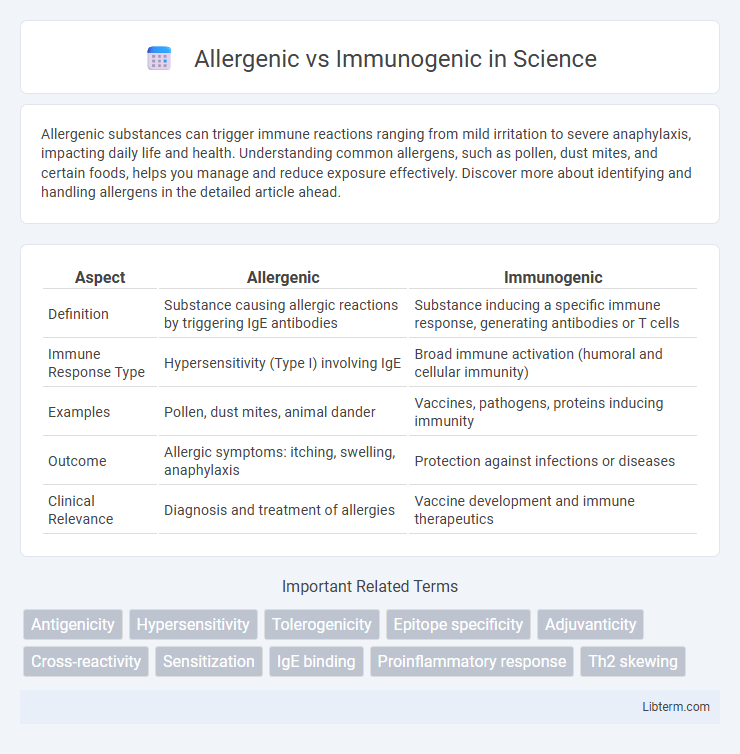Allergenic substances can trigger immune reactions ranging from mild irritation to severe anaphylaxis, impacting daily life and health. Understanding common allergens, such as pollen, dust mites, and certain foods, helps you manage and reduce exposure effectively. Discover more about identifying and handling allergens in the detailed article ahead.
Table of Comparison
| Aspect | Allergenic | Immunogenic |
|---|---|---|
| Definition | Substance causing allergic reactions by triggering IgE antibodies | Substance inducing a specific immune response, generating antibodies or T cells |
| Immune Response Type | Hypersensitivity (Type I) involving IgE | Broad immune activation (humoral and cellular immunity) |
| Examples | Pollen, dust mites, animal dander | Vaccines, pathogens, proteins inducing immunity |
| Outcome | Allergic symptoms: itching, swelling, anaphylaxis | Protection against infections or diseases |
| Clinical Relevance | Diagnosis and treatment of allergies | Vaccine development and immune therapeutics |
Understanding Allergenic vs Immunogenic: Key Definitions
Allergenic substances trigger allergic reactions by activating immune responses that lead to hypersensitivity, whereas immunogenic substances stimulate a broader immune response generating immunity against pathogens. Allergens commonly include proteins from pollen, dust mites, or animal dander that provoke IgE-mediated reactions, while immunogens are typically antigens designed to elicit antibody production or T-cell activation. Distinguishing between allergenic and immunogenic properties is crucial for vaccine development and allergy treatments, ensuring targeted immune modulation without adverse hypersensitivity.
How Allergens Trigger Immune Responses
Allergens trigger immune responses by being recognized as harmless proteins that stimulate the production of IgE antibodies, leading to sensitization and allergic reactions. This process involves the activation of mast cells and basophils, which release histamines and other mediators causing inflammation and symptoms like itching, swelling, and mucus production. Immunogenic substances, unlike allergens, primarily induce a protective immune response without causing hypersensitivity.
Mechanisms of Immunogenicity Explained
Immunogenicity refers to the ability of a substance to provoke an immune response, primarily by activating T cells and B cells through antigen presentation and cytokine release. Allergenic reactions are a subset of immunogenic responses characterized by hypersensitivity, typically involving IgE antibodies that trigger mast cell degranulation and histamine release. The mechanisms of immunogenicity involve the recognition of epitopes by immune receptors, antigen processing by dendritic cells, and subsequent clonal expansion of specific lymphocytes, driving adaptive immunity.
Common Allergenic Substances in Everyday Life
Common allergenic substances in everyday life include pollen, dust mites, pet dander, mold spores, and certain food proteins such as peanuts and shellfish, which trigger allergic reactions by activating the immune system. Allergenic substances specifically cause hypersensitive immune responses, leading to symptoms like sneezing, itching, and inflammation, whereas immunogenic substances broadly stimulate an immune response that may not result in allergy. Understanding these substances aids in managing allergies and distinguishing between benign immune activation and harmful hypersensitivity.
Factors Influencing Immunogenicity
Factors influencing immunogenicity include the molecular size, complexity, and foreignness of the antigen, which dictate the strength of the immune response. The presence of adjuvants, the route of antigen administration, and the genetic background of the host also play critical roles in determining the extent of immunogenicity. Understanding these factors enables the design of more effective vaccines and therapies, distinguishing immunogens from merely allergenic substances.
Differentiating Allergic Reactions from Immune Activation
Allergenic substances trigger hypersensitive immune responses leading to allergies, primarily mediated by IgE antibodies, while immunogenic agents provoke a broader immune activation involving T cells and antibody production without causing hypersensitivity. Allergic reactions involve mast cell degranulation and histamine release, resulting in symptoms like itching and swelling, whereas immunogenic responses facilitate protective immunity against pathogens. Distinguishing allergy from immunity is crucial for diagnosing and treating conditions, as allergenic responses cause harmful inflammation, whereas immunogenic reactions enhance defense mechanisms.
Genetic and Environmental Influences on Allergenicity
Genetic factors such as polymorphisms in HLA genes influence immune system recognition and response, shaping individual susceptibility to allergens. Environmental exposures, including pollution, diet, and microbial diversity, modulate the immune system's allergenic reactions by altering barrier function and immune regulation. The interplay between genetic predisposition and environmental triggers determines the intensity and development of allergenic versus immunogenic responses.
Clinical Implications of Allergens and Immunogens
Allergenic substances trigger hypersensitive immune responses leading to conditions such as asthma, eczema, and anaphylaxis, requiring targeted management strategies in clinical practice. Immunogenic agents stimulate protective immunity vital for vaccine design and immunotherapy, enabling the development of durable immune memory against infections and tumors. Understanding the distinct pathways of allergen-induced IgE-mediated reactions versus immunogen-driven T-cell responses is crucial for optimizing diagnostic and treatment modalities in allergy and immunology.
Diagnostic Approaches for Allergies and Immune Responses
Diagnostic approaches for allergenic and immunogenic responses involve distinct methodologies to accurately differentiate between allergic reactions and immune system activations. Skin prick tests and specific IgE assays primarily detect allergenic sensitivity by measuring immediate hypersensitivity responses to allergens like pollen or food proteins. In contrast, immunogenicity assessment often employs ELISpot assays and flow cytometry to evaluate T-cell activation and cytokine production, providing insights into broader immune responses beyond allergic manifestations.
Strategies for Managing Allergenic and Immunogenic Risks
Managing allergenic and immunogenic risks involves implementing robust screening methods such as in vitro assays and computational modeling to predict potential adverse immune responses. Strategies include protein engineering to modify or remove epitopes responsible for allergenicity and immunogenicity, alongside employing tolerance induction protocols to desensitize patients. Comprehensive risk assessment frameworks integrating clinical data and biomarker analysis are essential for minimizing immune-related adverse effects in therapeutic development.
Allergenic Infographic

 libterm.com
libterm.com